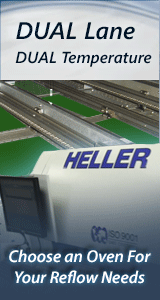Printed Circuit Board Assembly & PCB Design Forum
SMT electronics assembly manufacturing forum.
- SMTnet
- »
- Electronics Forum
- »
- ive solder profiles
ive solder profiles
Views: 4079
![]() I am having some problems with some of my pcbs at ive solder...
- Jul 29, 2008
by
garyr
I am having some problems with some of my pcbs at ive solder...
- Jul 29, 2008
by
garyr
![]()
![]()
![]() Hi,
for this kind of issues I will always go with the flu...
- Jul 29, 2008
by
gabriella
Hi,
for this kind of issues I will always go with the flu...
- Jul 29, 2008
by
gabriella
![]()
![]()
![]() We only use one type of flux for Lead Free. It is an alcoho...
- Jul 29, 2008
by
garyr
We only use one type of flux for Lead Free. It is an alcoho...
- Jul 29, 2008
by
garyr
![]()
![]()
![]() Any other suggestions????
...
- Aug 01, 2008
by
garyr
Any other suggestions????
...
- Aug 01, 2008
by
garyr
![]()
![]()
![]() If you are getting top side wetting, I doubt if this is a De...
- Aug 04, 2008
by
Real Chunks
If you are getting top side wetting, I doubt if this is a De...
- Aug 04, 2008
by
Real Chunks
![]()
![]()
![]() Patrick, you are right. I am sorry. It is a Water based fl...
- Aug 04, 2008
by
garyr
Patrick, you are right. I am sorry. It is a Water based fl...
- Aug 04, 2008
by
garyr
![]()
![]()
![]() Hey Patrick, thanks.
The area that is dark (half circle) is...
- Aug 04, 2008
by
garyr
Hey Patrick, thanks.
The area that is dark (half circle) is...
- Aug 04, 2008
by
garyr
![]()
![]()
![]() Have you tried the alcohol based flux on your ive yet? (even...
- Aug 05, 2008
by
Loco
Have you tried the alcohol based flux on your ive yet? (even...
- Aug 05, 2008
by
Loco
![]()
![]()
![]() GR@ICS, can you be mo...
- Aug 06, 2008
by
Chris1963
GR@ICS, can you be mo...
- Aug 06, 2008
by
Chris1963
![]()
![]()
![]() We have a 3/6 Nozzle We do have monitors. One of our pots i...
- Aug 06, 2008
by
garyr
We have a 3/6 Nozzle We do have monitors. One of our pots i...
- Aug 06, 2008
by
garyr
![]()
![]()
![]() I would have to second the opinion on the water based flux. ...
- Aug 08, 2008
by
Doug
I would have to second the opinion on the water based flux. ...
- Aug 08, 2008
by
Doug
![]()
![]()
![]() GR@ICS,
I copied a...
- Aug 11, 2008
by
Chris1963
GR@ICS,
I copied a...
- Aug 11, 2008
by
Chris1963
![]()
![]()
![]() Too much flux will spatter and can leave balls on either sid...
- Aug 11, 2008
by
Real Chunks
Too much flux will spatter and can leave balls on either sid...
- Aug 11, 2008
by
Real Chunks
![]()
![]()
![]() GR@ICS:
Are you dr...
- Aug 12, 2008
by
Dirk Nuendyke
GR@ICS:
Are you dr...
- Aug 12, 2008
by
Dirk Nuendyke
![]()
![]()
![]() I would like to thank everyone for their help on this one......
- Aug 20, 2008
by
garyr
I would like to thank everyone for their help on this one......
- Aug 20, 2008
by
garyr
![]()
![]()
![]() Let us know what the �sol� was we can all learn from it.
...
- Aug 20, 2008
by
Patrick Bruneel
Let us know what the �sol� was we can all learn from it.
...
- Aug 20, 2008
by
Patrick Bruneel
![]()
![]()
![]() use the 2009MLF from Interflux it will take away your solder...
- Sep 02, 2008
by
Wilma
use the 2009MLF from Interflux it will take away your solder...
- Sep 02, 2008
by
Wilma
![]()
- SMTnet
- »
- Electronics Forum
- »
- ive solder profiles







